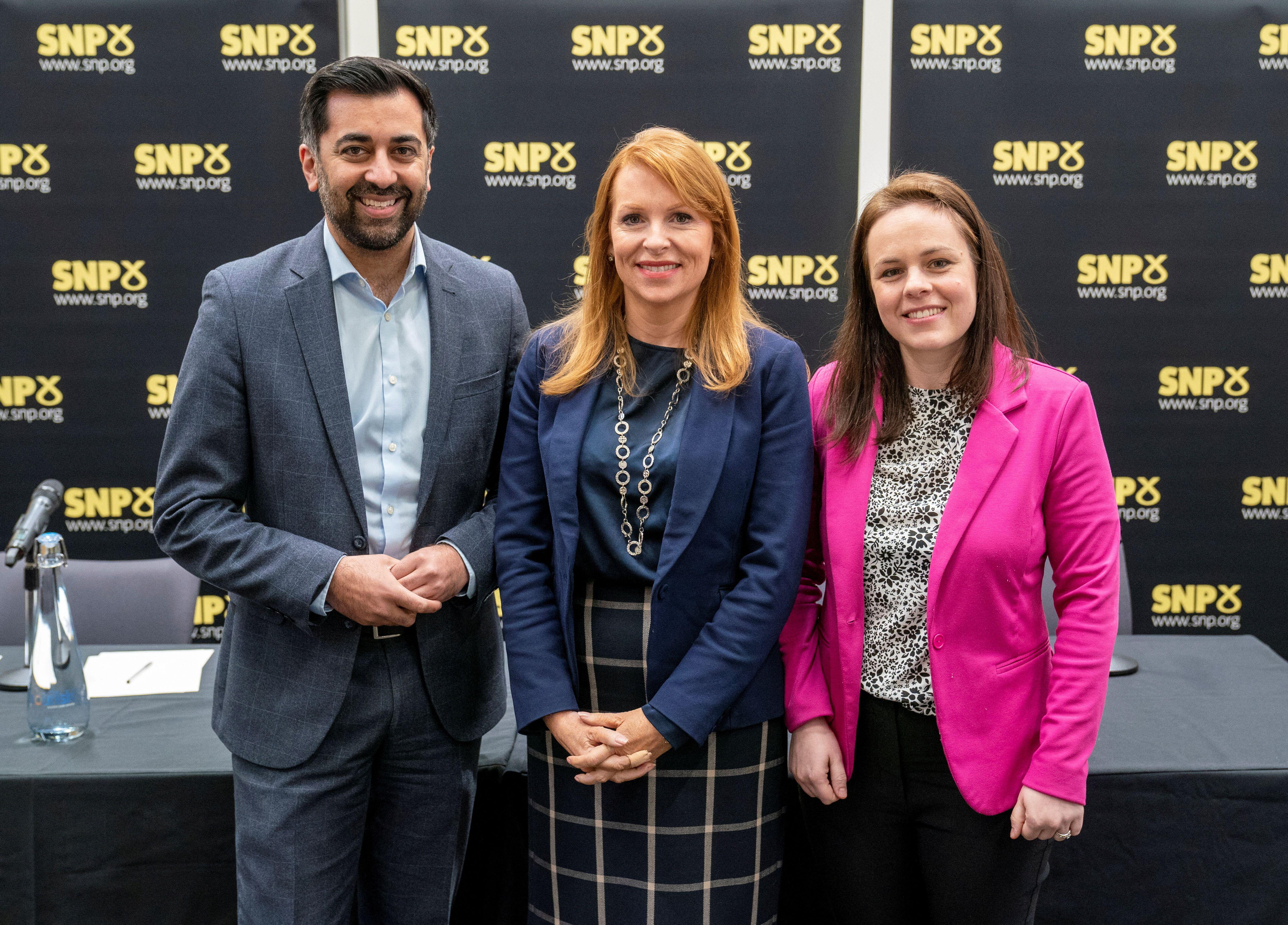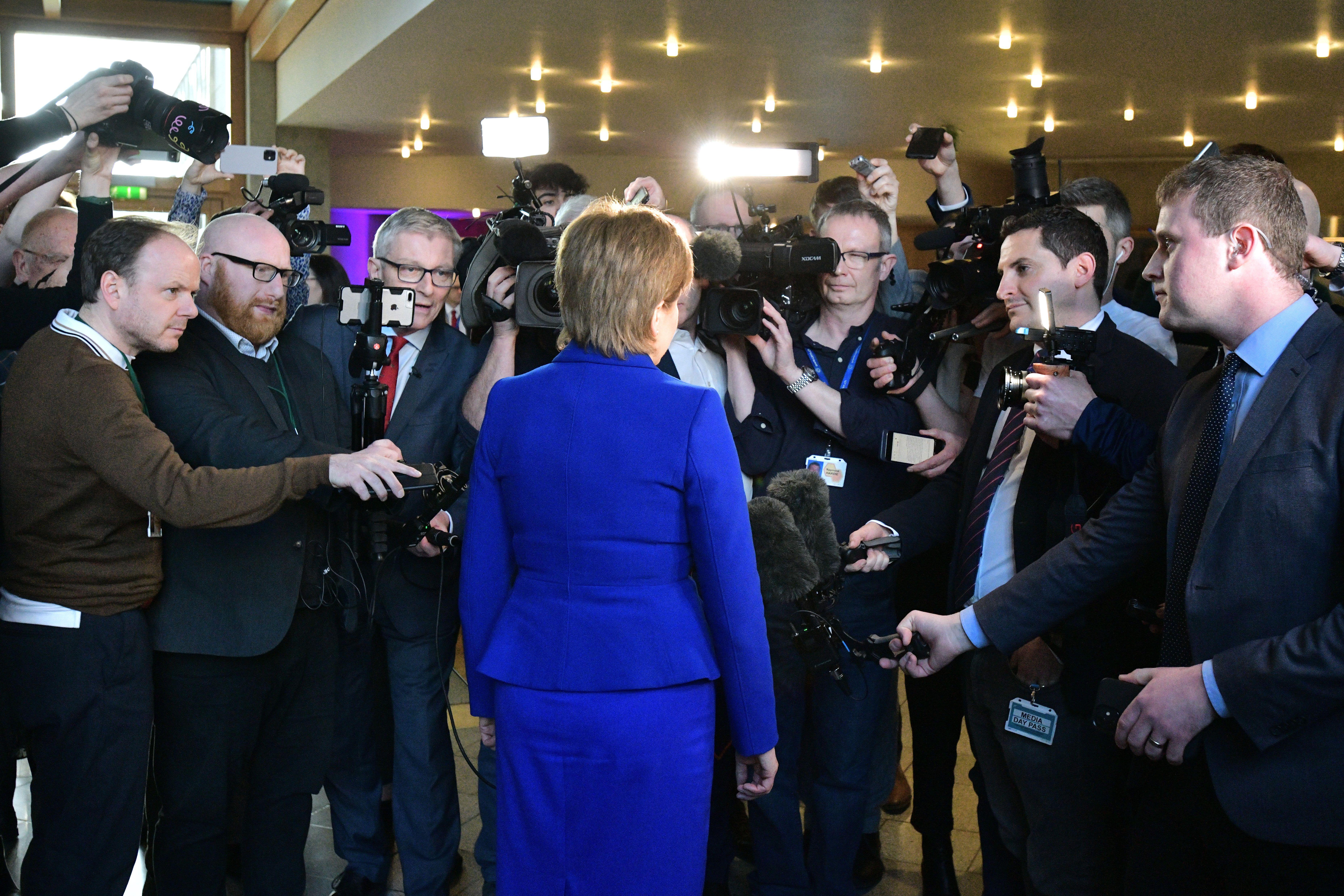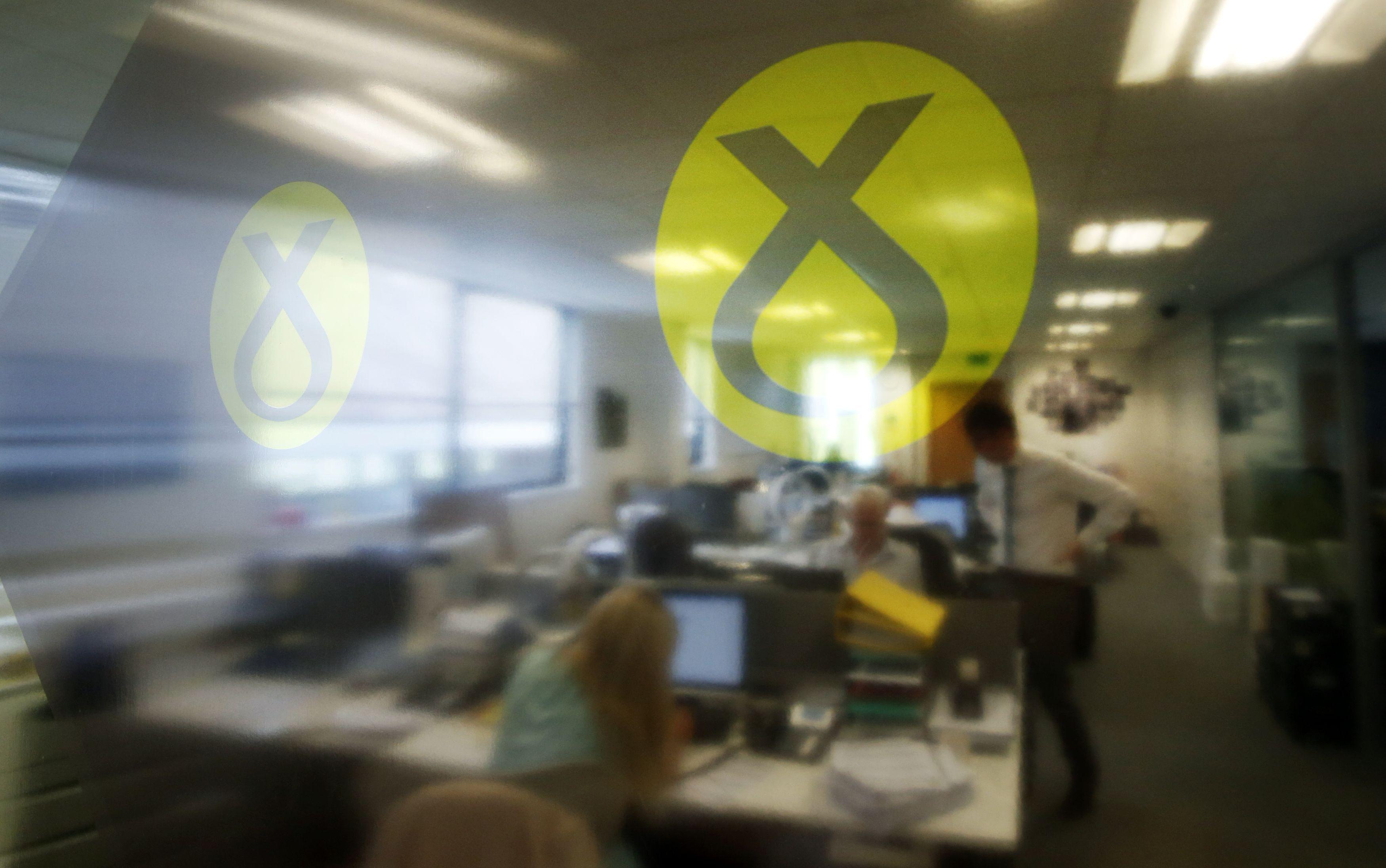Picking up the pieces: The SNP after Nicola Sturgeon
Scotland’s party of government has buckled and bent under the intense scrutiny that has accompanied its first open leadership election in almost 20 years.
A week is a long time in politics. But within a short space of time, the SNP has lost not only its most electorally successful leader in Nicola Sturgeon, but also her husband Peter Murrell, the long-serving chief executive who masterminded its rise, her right-hand adviser, Liz Lloyd, and the party’s well-known media chief, Murray Foote, with Deputy First Minister John Swinney leaving cabinet for the backbenches.
It has lost, too, tens of thousands of ordinary members in a short space of time – revelations which only emerged when candidates turned the focus away from themselves and onto the transparency of the internal election process.
Taking shots at each other, leadership hopefuls fired volleys also at party machinery, and at Scottish Government policy and performance. Amongst it all, reputations have been tarnished and political capital has been squandered. And polling revealed a public unconvinced by the contenders, with projected support at a general election on the slide.
All of this has happened in under six weeks. “It takes decades to build a party,” Alba leader Alex Salmond jabbed at his former colleagues, “but days to destroy one.”
It’s all unfolded with fewer than two years to go until the next general election, and while political rivals have made hay (“It’s comedy gold,” commented Labour’s Jackie Baillie after STV’s leadership hustings) SNP MPs elected as part of ‘the 56’ in 2015 have looked on from Westminster as Holyrood colleagues pulled at the fabric of their party. Some told Holyrood they’d considered looking out their CVs for the first time in years, unsure if the SNP could remain electable; others questioned if they still wanted to remain on the green benches at all. Others accused the leadership candidates – notably Ash Regan and Kate Forbes, who have been calling for truth and transparency from the party – of “Trumpian” behaviour.

Last week the leadership in Westminster told MPs to pare back their commentary on social media. The group is said to be more unified under the helm of Stephen Flynn, who took over in December. “They are members of parliament, not talking heads on Scotland Tonight,” Holyrood was told. “It’s either about providing a running commentary, or it’s about knuckling down.
“There’s a whole number of colleagues who can see a path to success still, but that’s going to depend on folk screwing the nut.
“A leadership contest is about stress-testing. The SNP has stress-tested itself to extreme levels.”
Political scientist Dr Lynn Bennie of Aberdeen University can’t think of any UK political rammies “on the same scale as this”. Few observers would disagree. “The SNP have been very controlled, if not controlling,” she says, “They’ve been run by a leadership that believes in clear strong communication coming from the top controlling any negative stories.”
But now Michael Russell, the president and acting chief executive of the SNP, has described the situation as a “tremendous mess”. It’s one of the party’s own making, Dr Alistair Clark of Newcastle University tells Holyrood. “A lot of what’s been going on has been fairly unnecessary and there have been a lot of issues caused by things that were fairly foreseeable,” he says.
“The SNP has always presented itself as being different to other political parties. Since Nicola Sturgeon stood down, it has become evident that they are just a normal political party with all the divisions that parties have. Pulling the various different sides of the party back together will be a difficult task.”

At the heart of the realisation that the SNP spins politics in the same way as other parties before it has been the issue of party membership numbers. The SNP has, we now know, shed tens of thousands of members, dropping 40 per cent of the 126,000 total amassed at its 2019 peak.
When the Sunday Mail caught wind of this earlier in the year and ran a front page story declaring that 30,000 members had gone, the SNP HQ issued an absolute denial, even ridiculing the premise of the story, with its communications chief, Foote, suggesting the number was out by 30,000. When the truth eventually emerged, prompted by calls from first Regan and Forbes followed by Humza Yousaf for the party to publish the numbers, Foote said he’d issued “agreed party responses” in “good faith and as a courtesy” to unnamed colleagues at headquarters. He fell on his sword and quit. The following day, amid calls for further clarity, Murrell also resigned. “Responsibility for the SNP’s responses to media queries about our membership number lies with me as chief executive,” he said, adding, “while there was no intent to mislead, I accept that this has been the outcome.”
The statement followed reports that the National Executive Committee planned to force him out with a vote of no confidence. Holyrood understands this was not the majority position. But the row is related, one SNP insider says, to a “creeping culture of not being open and free with information” which has led to “suspicion and people assuming the worst”. It’s a charge Sturgeon has faced as FM, with ministers privately asserting that they had few one-to-one exchanges with their boss, and little or no involvement in government decisions. “Ministers were talking about the government as if it was something else, some other entity,” says the source. “You would think, ‘hang on, you’re in the government’.
“It comes from a defensive instinct, not wanting to give away too much. People think they are not in the loop, and then you think, maybe there isn’t one.
“Maybe the organisation’s intention wasn’t a bad one, but it ends up being bad. It doesn’t take very long before it begins to be your reputation: ‘you can’t really believe what they say’.”
Appearing on Loose Women, Sturgeon denied the SNP is in a “mess” while also claiming to have not known membership numbers herself, and also suggesting that the ‘misleading’ answers to membership numbers from HQ had been because they were trying to answer specific questions about why people had left. Whether her explanations are credible or not, her successor inherits problems over trust, policy, popularity and personnel. It’s unclear who will take Murrell’s role, and there are questions over whether a wider clear-out will unfold at senior levels. Complaints over discipline, selections and more have bubbled over into the public domain for years, with suggestions that party machinery failed to keep pace with growth.

“Many people have known for some time that there have been issues of governance within HQ,” another source says. “Decision making has been vested in the hands of very few people.
“Governance of membership organisations is notoriously difficult – any lawyer will tell you it’s fraught with challenges. It will require careful reflection on what steps are to be taken next. If it were me, I’d be looking for professional advice.”
For others, the engine driving the party needs repair, but not replacement. “It would be fair to say that the leadership election was not the finest moment in SNP history, but it doesn’t change the fundamental facts – the SNP is an election-winning machine and has been for more than a decade,” an elected member says, arguing that its internal management “remains head and shoulders above any equivalent operations from other political parties in Scotland”. “The new leader is going to inherit a strong foundation to build upon,” he adds.
And, indeed, polling from Ipsos revealed Nicola Sturgeon has the highest favourability rating of any UK political leader as she steps down, with the SNP still Scotland's most popular party. However, there remain clear and public issues to address.
While there has been much commentary about the membership drop, the SNP remains Scotland’s biggest party by far. Scottish Labour was on around 16,500 two years ago, while the Scottish Greens, which experienced a post-referendum boom, dropped from around 9,000 in 2015 to 8,000 the year after. The new SNP leadership inherits a broad but diminished base, and though there are suggestions that this is linked to disillusionment with the party’s record in government and the now-blocked Gender Recognition Reform Bill – yet another facet of the Sturgeon legacy – much remains unknown, including the profile of those with discontinued memberships.
In their 2021 paper Parties, movements and the 2014 Scottish independence referendum, Bennie and colleagues found post-indyref recruits to the SNP and Greens had “experienced a sense of belonging to a Yes movement during the campaign but were not intensely active”. “What differentiates the new recruits,” they wrote, is “their weaker commitment to traditional party politics.”

Bennie wonders “how much voters are actually tuned in” to the minutiae of the SNP’s current troubles. “They’ll be noticing negative headlines, but to what extent that will make a difference, we just don’t know,” she says.
“What they are looking for is a basic level of competence. That’s what the SNP did deliver for many years. They’ve communicated what their achievements were in government and all the electoral study information shows they convinced voters they were competent and standing up for Scotland’s interests. Most of the electoral success came on the back of that combination, not on support for independence.”
Sturgeon’s now-shelved “de facto” referendum strategy was “just poor judgement,” Bennie says. “It was the sort of policy that was difficult to communicate. That to me was surprising; that’s not the SNP of old. It maybe came from a place where it looked like their options were running out.”
While rivals seek opportunity in the SNP’s woes, Bennie says there is no sense that Labour is poised to “suddenly be a major force again”. “It’s just very possible that this party will just move on,” she says of the SNP.
“I’m relatively confident the party will come back together,” one parliamentarian comments. “Some supporters will flounce in a huff, but the reality is people have got to consider what’s important to them. If independence is the glue that holds the SNP together, some people have to see if they have enough to stay stuck on.”
However, Clark says the SNP is undergoing “generational change” and its policy focus has been “diluted” by Scotland’s “near-permanent elections cycle”. “The energy of 2014 has been behind the SNP’s growth as a membership party, and people have realised independence is a much longer slog than they thought,” he says. “Elections tend to have a disciplining effect. We are not that far out from the next general election; I expect the SNP to start getting back into line and getting back into that campaign mode.
“Peter Murrell probably deserves credit for making the SNP a disciplined organisation. Of course, that has its downsides. If you have one strong leader figure you don’t have necessarily the depth around you to transition. He has been unusual because he has been in that position for so long; political chief executives tend to have higher turnover.
“The SNP have to resolve the internal problems then focus outwards, and ultimately on delivery of policy. People notice when they can’t get GP appointments and when public services are under pressure. These are basics the SNP understood a while back. Their relearning will be really important.”
Holyrood Newsletters
Holyrood provides comprehensive coverage of Scottish politics, offering award-winning reporting and analysis: Subscribe